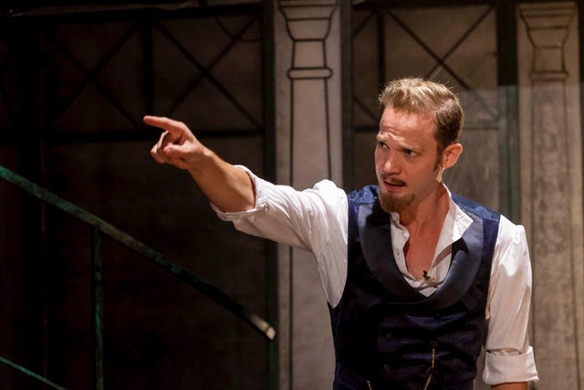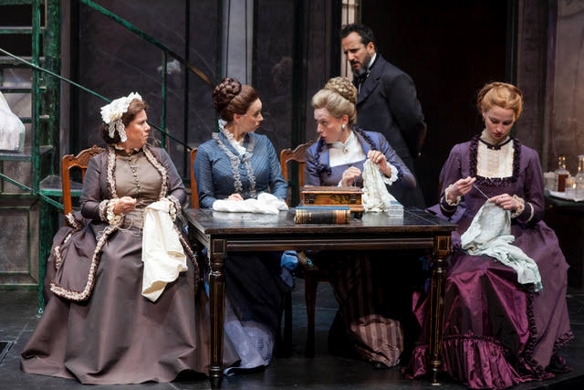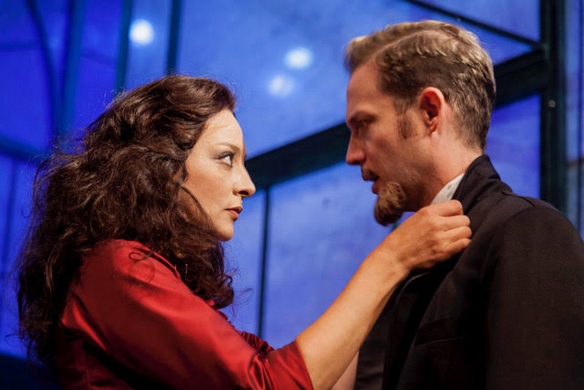The Cameri Theatre production of Henrik Ibsen’s Pillars of Society represents classic theatre at its best. Directed by Arthur Kogan, who adapted and translated it with Itay Tiran, the play retains a solid fidelity to Ibsen and the era, as set, costumes, lights, music and excellent ensemble performances come together in a harmonious, and profound whole. As the plot thickens and the play’s themes develop, the relevance to contemporary concerns shines through with effortless clarity. Although a cursory perusal of the news might give readers the impression that corruption and duplicity are not only modern innovations, but possibly one of Israel’s most successful start-ups, an evening in the company of Ibsen is an excellent reminder of the eternal aspect of these human qualities.
Pillars of Society, first performed in 1877, comes before a succession of more popular Ibsen plays – A Doll’s House, An Enemy of the People, The Master Builder, and others. The play’s conclusion is considered problematic, and yet, when viewed in a certain regard, perhaps not so.

The play centers on Karsten Bernick (Itay Tiran), a shipping magnate in a small, rather isolated, coastal town in Norway. A prominent, wealthy businessman, he has contributed much to the community and is revered by the community. Yet the discrepancy between the smooth façade and underlying schemes, manipulations, and deceptions is intimated from the outset. One senses the burgeoning turmoil before it is stated, thanks to the ingenious set and lighting. Alexander Lisiansky’s set resembles a glass house with decorative leading, its divisions and movement in tandem with the lighting evoke a sense of interior and exterior, opaque and transparent, that reflect the underlying themes of the play.

Kogan allows the plot to unfold at a measured pace, as one becomes acquainted with the town and its people. Self-contained and content, the placidity is soon ruptured from without and within. A circus arrives, bringing with it ghosts from the past; while Bernick does a 180° turn to promote the building of a railroad through the town, a project he had emphatically vetoed. The community’s relative isolation from the wider world, and the conflict between conservative values and modernity are central to the play. Yet the morality and contentment that the good citizens seek to preserve, as exemplified by schoolmaster Rorland (Yoav Levy) and the good women’s society, is superficial at best. There are subjects that one does not discuss, and people who do not belong.

The return of Johan Tonnesen (Asaf Solomon) and Lona Hessel (Helena Yaralova), the younger brother and stepsister of Betty, Karsten Bernick’s wife, ignite the fuse. From the moment of their arrival, the tension builds in a series of explosions and revelations. Johan and Lona represent not only the hidden, scandalous, past, but the future, the looming specter of modernity. They have spent the past 15 years in America, the land of new beginnings that stands in sharp contrast to the traditional European culture. Unlike Bernick’s wife Betty and the other townswomen, Lona is far from obedient, modest, and submissive. Yaralova infuses this role with mesmerizing vivacity and passion, Lona’s blunt honesty – towards herself as well as others, is a breath of fresh air in the suffocating atmosphere of hypocrisy and repression.
While it is apparent that Bernick is not the model citizen he claims to be, the gradual pace of the play enables the character to be more fully realized for all his traits. His intelligence, confidence, and drive make him a good leader in many ways, while his selfishness, corruption and duplicity have caused much harm and pain. Pillars of Society finds its resolution on a far more mellow note than one might anticipate. There are some who would claim this as a fault, seeking a more dramatic, tragic outcome. Yet, there is an aspect of this resolution that strikes a note of authenticity, a disturbing, yet very resonant authenticity. For when the pillars of society are exposed in their wrongdoing, their gifts of spin and survival may indeed come to their aid, their admission of guilt rendering them ironically all the more admirable in the eyes of their constituency.
Pillars of Society
By Henrik Ibsen; Adapted and translated by Arthur Kogan and Itay Tiran; Directed by Arthur Kogan; Set design: Alexander Lisiansky; Costume design: Moni Mednik; Lighting design: Uri Morag; Music editing: Itay Tiran and Valery Reizes; Sound design: Valery Reizes; Assistant directors: Efrat Liphshitz, Asaf Fridman; Cast: Itay Tiran, Anastasya Fein, Aviv Zalishansky/Ori Eitan/Idan Shalev, Kineret Limoni, Asaf Solomon, Helena Yaralova, Uri Rawitz, Joy Rieger, Yoav Levy, Simcha Barbiro, Tal Weiss, Gil Weinberg, Eran Sarel, Andrea Schwartz, Aya Granit Shva, Roni Sheindorf





